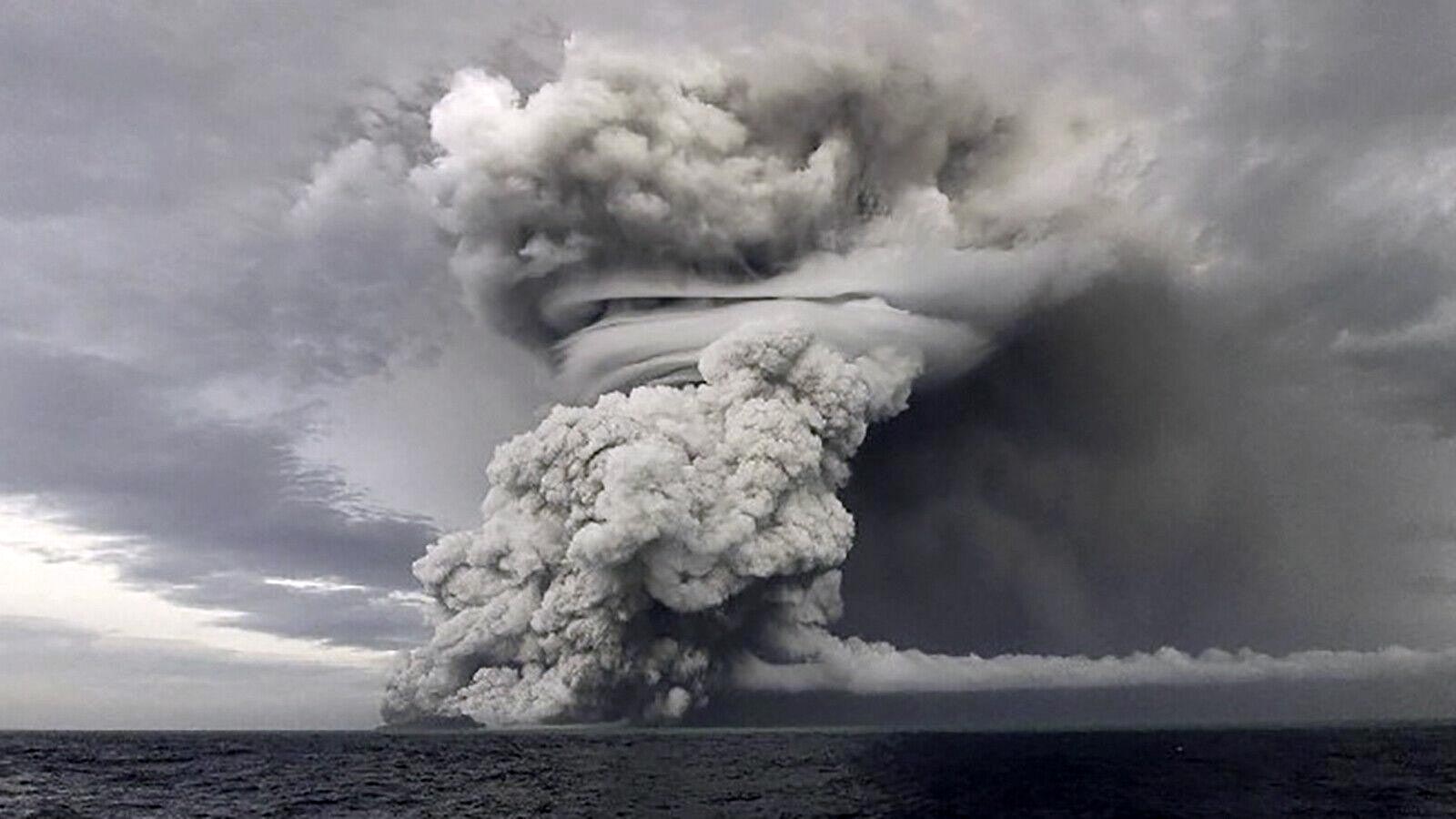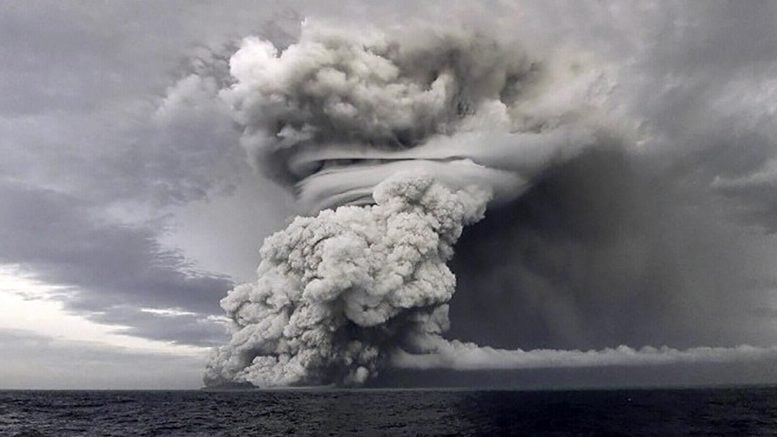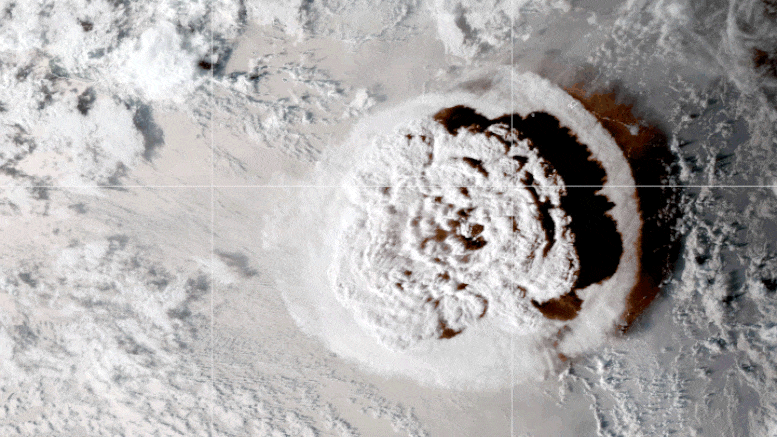

Hunga Tonga volcano, pictured during an eruption on 14 and 15 January 2022. Copyright: Tonga Geological Services / Zuma Press / Zuma / IAEA (Courtesy of Dr Mark Schoberl)
The Hunga Tonga eruption is widely believed to be responsible for the dramatic warming of the Earth over the past two years, and researchers say it actually cooled the climate.
Research from Texas A&M University explores the climate impacts of the 2022 Hunga Tonga volcano eruption, finding that it caused cooling rather than warming. This contradicts previous beliefs and underscores the need for continued satellite data to understand climate dynamics, reinforcing the dominant role of human-caused emissions in climate change.
A collaborative research team, including atmospheric scientist Dr. Andrew Dessler of Texas A&M University, is investigating the climate impacts of the 2022 Hunga Tonga volcano eruption, while challenging previous assumptions about its impact.
The spectacular two-day event, which occurred in mid-January 2022, injected massive amounts of volcanic aerosols and water vapor into the atmosphere. Historically, large volcanic eruptions such as Tambora in 1815 and Mount Pinatubo in 1991 have had significant cooling effects on the global climate by blocking sunlight with their aerosols. However, the Hunga Tonga eruption presented a unique scenario: As an underwater volcano, it injected an unprecedented amount of water vapor into the stratosphere, increasing the total water content of the stratosphere by about 10%.
Because water vapor is a powerful greenhouse gas, Dessler says there was initial speculation that it could be responsible for the extreme global warming in 2023 and 2024. Instead, the team’s findings, published July 24 in National Geographic, suggest that it could be responsible for the warming of global temperatures in 2023 and 2024. Journal of Geophysical Research: Atmospherereveals the opposite: the eruption has actually contributed to cooling Earth, like other major volcanic events.

The GOES-17 satellite captured images of a canopy cloud from the underwater eruption of the Hunga Tonga-Hunga Ha’apai volcano on January 15, 2022. Crescent-shaped shock waves and multiple lightning strikes can also be seen. Credit: NASA Earth Observatory image by Joshua Stevens using GOES imagery courtesy of NOAA and NESDIS
Cooling effect of volcanic eruption
The team’s paper, titled “Evolution of Climate Forces in the Two Years Following the Hunga Tonga-Hunga Ha’apai Eruption,” includes insights and analysis from Dessler, a professor in the Department of Atmospheric Sciences at Texas A&M University and director of the Texas Center for Climate Studies; first author Dr. Mark Schoberl, a senior scientist at the Virginia Science and Technology Foundation based in Hamburg, Virginia; and several scientists from the National Aeronautics and Space Administration (NASA).
Their methodology included analysis. NASA The researchers used NOAA satellite data, aerosols, and water vapor, among other variables, to estimate the energy balance in Earth’s climate system. Their analysis revealed that the eruption caused more energy to leave the climate system than enter it, thus producing a slight cooling effect.
“Our paper pours cold water on the explanation that a volcanic eruption caused the extreme temperatures in 2023 and 2024,” Dessler explained. “Instead, we need to focus primarily on human-caused greenhouse gases as the primary cause of global warming, with a big helping hand from the ongoing El Niño.”
Implications and future research
According to Dessler, the research has important implications for scientists and the general public. By dismissing volcanic eruptions as a major factor in recent global warming, the team’s study reinforces its view that human-caused greenhouse gas emissions are the primary driver of climate change. This focus is especially important, given the ongoing debate and misinformation about the causes of global warming.
Furthermore, Schoberl says the study underscores the importance of continuing to invest in satellite-based stratospheric measurements.
“Our understanding of the Hunga Tonga eruption is largely due to investment in stratospheric satellite measurements by National Oceanic and Atmospheric Administration “NASA and NASA have done a lot of work over the past two decades,” Schoberl added. “However, we have to be careful about the possibility of a ‘stratospheric data desert’, where some of the most important instruments have not been replaced.”
Unresolved Questions and the Way Forward
While the paper answers many important questions, Dessler acknowledges that it also raises new ones. For example, the researchers highlight some unresolved issues surrounding the Hunga Tonga eruption, such as the unexpectedly low levels of sulfur dioxide produced by such a violent eruption and the small impact the eruption had on the 2023 ozone hole. The 2023 ozone hole indicates a significant thinning of the ozone layer over Antarctica, allowing more harmful ultraviolet radiation to reach the Earth’s surface. Additionally, the persistence of water vapor in the stratosphere beyond what models predicted suggests that there is still much to learn about stratospheric circulation processes.
As scientists work to solve ongoing questions and deepen our understanding of the stratosphere, Schoberl says the team’s work highlights the urgent need for continued research and accurate data to meet the challenges of climate change.
Reference: “Evolution of climate forcing during the two years following the Hunga Tonga-Hunga Ha’apai eruption” by M. R. Schöberl, Y. Wang, J. Taha, D. J. Zawada, R. Oyama, and A. Dessler, 24 July 2024, Journal of Geophysical Research: Atmosphere.
DOI: 10.1029/2024JD041296

“Web maven. Infuriatingly humble beer geek. Bacon fanatic. Typical creator. Music expert.”





More Stories
Scientists confirm that monkeys do not have time to write Shakespeare: ScienceAlert
SpaceX launches 23 Starlink satellites from Florida (video and photos)
A new 3D map reveals strange, glowing filaments surrounding the supernova